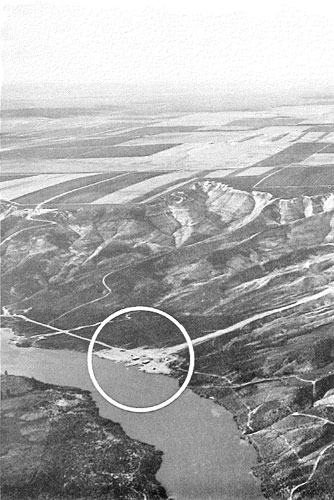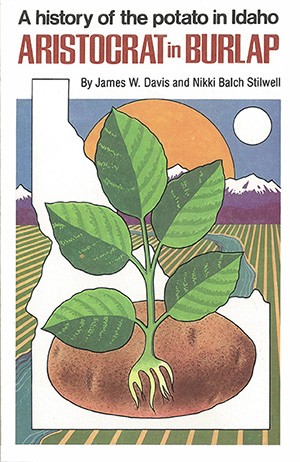 The first pumping plant can be seen at river level.
The first pumping plant can be seen at river level.
The irrigation system proved to have design flaws, and pest and disease problems along with a shortage of water have made it necessary for much of the acreage to be utilized for crops other than potatoes. More storage facilities were built than present production can utilize and some are now unused.
A later addition to desert entry projects in Idaho was one contiguous to the Sailor Creek project called Grindstone Butte. Grindstone Butte had the advantage of the experience acquired during the development of Sailor Creek and the land was of equal quality with the same potential for agricultural productivity. Potato production is still a major factor at Grindstone and Sailor Creek, and the per-acre yields rank with the highest in the state. There has also been considerable crop diversification with mint being a recent addition to the rotation cycle.
Several factors entered the high-lift pumping project picture, however, that discouraged further development. With the advent of rising prices, the later projects rose correspondingly in development cost. Pumping equipment, water distribution systems, access roads, laterals, and sprinkler systems all became more expensive until development costs reached more than $300 per acre on the later projects. Continued high prices for agricultural products might have made future projects possible until the oil embargo and the disastrous increases in energy costs in 1974 made new investments in high-lift pumping impractical.
The cost of electrical energy for pumping increased sevenfold from the rates that were in effect when the projects were put in. The evolution of project ownership also proved to be a function of economics. The entrymen who were not well financed found that they could not survive several years of low farm prices and most sold out to neighbors. The projects now typically are owned by two or three farmers who run large, efficient operations.
At the time the projects went in, there was a surplus of water in the Snake River, and it seemed that Idaho farmers could continue to reclaim huge tracts of desert. That situation has changed, however, as all the water has been claimed for agriculture, power generation, city-water supplies, and the maintenance of migratory fish runs. If a new development were to be proposed, there would be no water on which the project owners could file for the irrigation of crops.


 The first pumping plant can be seen at river level.
The first pumping plant can be seen at river level.